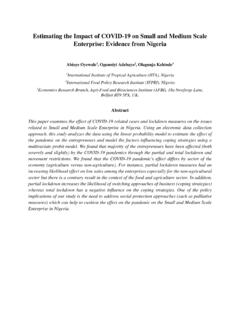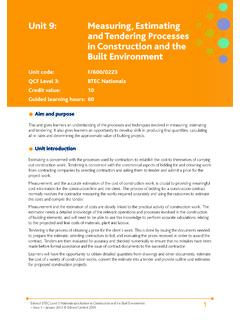Transcription of Improving Fan System Performance - NREL
1 TOFENERGYDEPARTMENUENITEDSTATSOFAERICAMI mprovingFan SystemPerformancea sourcebook for Department of EnergyEnergy Efficiency and Renewable EnergyOne of a series ofindustrial energyefficiency sourcebooksa sourcebook for industryBringing you a prosperous future where energy is clean, abundant, reliable, and affordableImprovingFan SystemPerformanceAcknowledgmentsImprovin g Fan System Performance : A Sourcebook for Industryhas been developed by the Departmentof Energy s (DOE) Industrial Technologies Program and the Air Movement and Control AssociationInternational, Inc. (AMCA), a DOE Allied Partner. Industrial Technologies and AMCA International undertook this project as part of a series of sourcebook publications on motor-driven equipment under theBestPractices effort. Other topics in this series include compressed air systems, pumping systems, and motorsand drives. For more information about the Industrial Technologies BestPractices effort and AMCAI nternational, see Section International is a not-for-profit association of the world s manufacturers of related air System equipment primarily, but not limited to fans, louvers, dampers, air curtains, airflow measurement stations,acoustic attenuators, and other air System components for industrial, commercial, and residential association s mission is to promote the health and growth of industries covered by its scope and the members of the association consistent with the interests of the , AMCA International, Lawrence Berkeley National Laboratory, and Resource Dynamics Corporation thankthe staff at the many organizations that so generously assisted in the collection of data for this contributions of the following participants are appreciated for their review and input to this sourcebook.
2 Gary Benson, The New York Blower CompanyFrank Breining, Airmaster Fan CompanyDon Casada, Diagnostic Solutions, LLCBrad Gustafson, Department of EnergyTom Gustafson, Hartzell Fan, Quinn, American Fan Company & Woods USA DivisionPaul Saxon, Air Movement and Control Association International, Smiley, The Trane CompanySastry Varanasi, ABB Fan Group North AmericaDick Williamson, Twin City Fan Companies, Wroblewski, Productive Energy SolutionsPrepared for:The United States Department of EnergyAir Movement and Control Association International, by:Lawrence Berkeley National LaboratoryWashington, DCResource Dynamics CorporationVienna, VACover photo credit: Copyright CML Northern Blower Inc., 1989. All rights reserved. This image may not be reproduced, stored, or transmitted in any form or means without the prior written consent of the copyright Start GuideSection 1: Introduction to Fan SystemsFans3 Fan Performance Curves6 Fan System Components9 Section 2: Performance Improvement Opportunity Roadmap1 Assessing Fan System Needs172 Fan Types193 Basic Maintenance254 Common Fan Systems Problems295 Indications of Oversized Fans336 System Leaks377 Configurations to Improve Fan System Efficiency398 Controlling Fans with Variable Loads439 Fan Drive Options4710 Multiple-Fan Arrangements5111 Fan System Economics55 Section 3: Programs, Contacts, and ResourcesIndustrial Technologies Program and BestPractices59 Air Movement and Control Association International, Inc.
3 (AMCA International) 63 Directory of Contacts65 Resources and Tools67 AppendicesAppendix A: Fan System Terminology75 Appendix B: The Fan System Marketplace83iA Sourcebook for IndustryContents13155975 Improving Fan System Performanceii1A Sourcebook for IndustryThis sourcebook is designed to provide fan systemusers with a reference outlining opportunities toimprove System Performance . It is not intended tobe a comprehensive technical text on improvingfan systems, but rather a document that makes usersaware of potential Performance improvements,provides some practical guidelines, and details wherethe user can find more help. The sourcebook isdivided into three main sections and appendices. Section 1: Introduction to Fan SystemsFor users unfamiliar with the basics of fans and fansystems, a brief discussion of the terms, relationships,and important System design considerations is provided. This section describes the key factorsinvolved in fan selection and System design andprovides an overview of different types of fans andthe applications for which they are generally already familiar with fan System operationmay want to skip this section.
4 The key terms andparameters used in selecting fans, designing systems, and controlling fluid flow are discussed. Section 2: Performance Improvement Opportunity RoadmapThis section describes the key components of a fansystem and the opportunities for Performance improve-ments. Also provided is a figurative System diagramidentifying fan System components and performanceimprovement opportunities. A set of fact sheetsdescribing these opportunities in greater detail follows the diagram. These fact sheets cover:1. Assessing Fan System Needs2. Fan Types3. Basic Fan Systems Problems5. Indications of Oversized Fans6. System to Improve Fan System Efficiency8. Controlling Fans with Variable Loads9. Fan Drive Options10. Multiple-Fan System Economics Section 3: Programs, Resources, and ContactsSection 3 provides a directory of associations andother organizations involved in the fan marketplace,along with a listing of the resources, tools, software,videos, and workshops.
5 AppendicesThe sourcebook includes two appendices. Appendix Ais a glossary that defines terms used in the fan System industry. Appendix B presents an overviewof the fan System Systems ApproachThe cost-effective operation and maintenance of afan System requires attention not only to the needsof the individual pieces of equipment, but also tothe System as a whole. A systems approach analyzes both the supply and demand sides of thesystem and how they interact, essentially shiftingthe focus from individual components to total System Performance . Often, operators are so focusedon the immediate demands of the equipment thatthey overlook the broader question of how systemparameters are affecting the equipment. The systems approach usually involves the followingtypes of interrelated actions: Establishing current conditions and operating parameters Determining present and estimating future process production needs Gathering and analyzing operating data and developing load duty cycles Assessing alternative System designs and improvements Determining the most technically and economically sound options, taking into consideration all of the subsystems Implementing the best option Assessing energy consumption with respect to Performance Continuing to monitor and optimize the System Continuing to operate and maintain the System for peak Start GuideQuick Start Guide2 Improving Fan System PerformanceA Sourcebook for Industry3 Fans1are widely used in industrial and commercialapplications.
6 From shop ventilation to materialhandling to boiler applications, fans are critical for process support and human health. In the manufacturing sector, fans use about billionkilowatt-hours2of energy each year. This con-sumption represents 15 percent of the electricityused by , in the commercial sector, electricity needed to operate fan motorscomposes a large portion of the energy costs forspace conditioning. Performance may range from free air to severalpounds per square inch gage (psig)4, with airflow from a few cubic feet per minute (cfm) to more than 1 million cfm. Pressures above 15 psig generally require air compressors, whichare addressed in a separate sourcebook titledImproving Compressed Air System Performance , ASourcebook for Industry. In manufacturing, fan reliability is critical to plantoperation. For example, where fans serve materialhandling applications, fan failure will immediatelycreate a process stoppage. In industrial ventilationapplications, fan failure will often force a processto be shut down (although there is often enoughtime to bring the process to an orderly stoppage).
7 Even in heating and cooling applications, fan operation is essential to maintain a productive workenvironment. Fan failure leads to conditions inwhich worker productivity and product qualitydeclines. This is especially true for some productionapplications in which air cleanliness is critical tominimizing production defects (for example, plastics injection molding and electronic componentmanufacturing). In each case, fan operation has a significant impacton plant production. The importance of fan reliabilityoften causes System designers to design fan systems conservatively. Concerned about beingresponsible for under-performing systems, designerstend to compensate for uncertainties in the designprocess by adding capacity to fans. Unfortunately,oversizing fan systems creates problems that canincrease System operating costs while decreasingfan that are oversized for their service requirementsdo not operate at their best efficiency points. Insevere cases, these fans may operate in an unstablemanner because of the point of operation on thefan airflow-pressure curve.
8 Oversized fans generateexcess flow energy, resulting in high airflow noiseand increased stress on the fan and the , oversized fans not only cost more topurchase and to operate, they create avoidablesystem Performance problems. The use of a systems approach in the fan selection processwill typically yield a quieter, more efficient, andmore reliable are two primary types of fans: centrifugaland axial. These types are characterized by thepath of the airflow through the fan. Centrifugalfans use a rotating impeller to increase the velocityof an airstream. As the air moves from the impellerhub to the blade tips, it gains kinetic energy. Thiskinetic energy is then converted to a static pressureincrease as the air slows before entering the fans are capable of generating relativelyhigh pressures. They are frequently used in dirty airstreams (high moisture and particulate content),in material handling applications, and in systemsat higher temperatures. Section 1: Introduction to Fan Systems1 For the purposes of this sourcebook, the term fan will be used for all air-moving machines other than States Industrial Electric Motor Systems Market Opportunities Assessment, U.
9 S. Department of Energy, December standard conditions, a column of water inches high exerts 1 psig of pressure. Equivalently, 1 inch of water gage = to Fan SystemsImproving Fan System Performance4 Axial fans, as the name implies, move an airstreamalong the axis of the fan. The air is pressurized bythe aerodynamic lift generated by the fan blades,much like a propeller and an airplane they can sometimes be used interchange-ably with centrifugal fans, axial fans are commonlyused in clean air, low-pressure, high-volumeapplications. Axial fans have less rotating mass andare more compact than centrifugal fans of compa-rable capacity. Additionally, axial fans tend to havehigher rotational speeds and are somewhat noisierthan in-line centrifugal fans of the same capacity;however, this noise tends to be dominated by highfrequencies, which tend to be easier to attenuate. Fan SelectionFan selection is a complex process that starts witha basic knowledge of System operating requirementsand conditions such as airflow rates, temperatures,pressures, airstream properties, and System variability of these factors and other consider-ations, such as cost, efficiency, operating life,maintenance, speed, material type, space con-straints, drive arrangements, temperature, andrange of operating conditions, complicate fanselection.
10 However, knowledge of the importantfactors in the fan selection process can be helpfulfor the purposes of reducing energy consumptionduring System retrofits or expansions. Often, a fantype is chosen for nontechnical reasons, such asprice, delivery, availability, or designer or operatorfamiliarity with a fan model. If noise levels, energycosts, maintenance requirements, System reliability,or fan Performance are worse than expected, thenthe issue of whether the appropriate fan type wasinitially selected should be revisited. Fans are usually selected from a range of modelsand sizes, rather than designed specifically for a particular application. Fan selection is based on calculating the airflow and pressure require-ments of a System , then finding a fan of the rightdesign and materials to meet these , there is a high level of uncertaintyassociated with predicting System airflow and pressure requirements. This uncertainty, combinedwith fouling effects and anticipated capacityexpansion, encourages the tendency to increasethe specified size of a fan/motor assembly.
















